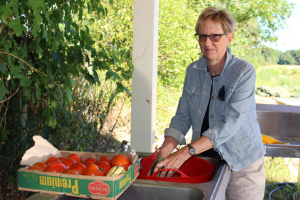Written by Patsy Evans for Naturally@UConn and originally posted on October 14, 2014
 Hearing the word ‘outbreak’ makes many people anxious. E. coliO157:H7, spinach, 2006. Salmonella, peanut butter, 2009. Listeria, cantaloupe, 2011. Diane Hirsch, UConn Extension educator for food safety, easily lists previous food-borne pathogen outbreaks. But, fear does not paralyze her.
Hearing the word ‘outbreak’ makes many people anxious. E. coliO157:H7, spinach, 2006. Salmonella, peanut butter, 2009. Listeria, cantaloupe, 2011. Diane Hirsch, UConn Extension educator for food safety, easily lists previous food-borne pathogen outbreaks. But, fear does not paralyze her.
Instead, she works in classrooms and on farms to make sure that locally produced food, which ends up on tables in New England, is as safe as possible. Her mission: “safe food handling from farm to table.” Her audience includes growers who put produce in boxes on their farms, commercial artisanal cheese makers and home cooks who preserve food in their kitchens.
With the help of over $82,000 in USDA grants, Hirsch trains farmers to follow Good Agricultural Practices (GAP) and processors to develop food safety plans. She labors to see farm products that are, according to USDA, “produced, packed, handled, and stored in the safest manner possible to minimize risks of microbial food safety hazards.”
Because of past outbreaks, grocery store chains that buy food from farmers are putting more pressure on them to follow food safety guidelines and submit to voluntary audits. Hirsch estimates that 12 to 14 Connecticut farmers are currently GAP audited. She wants her training programs and farm visits to increase that number by “helping people do what they need to do” in reducing the possibility of contamination and preparing for audits.
Read more…